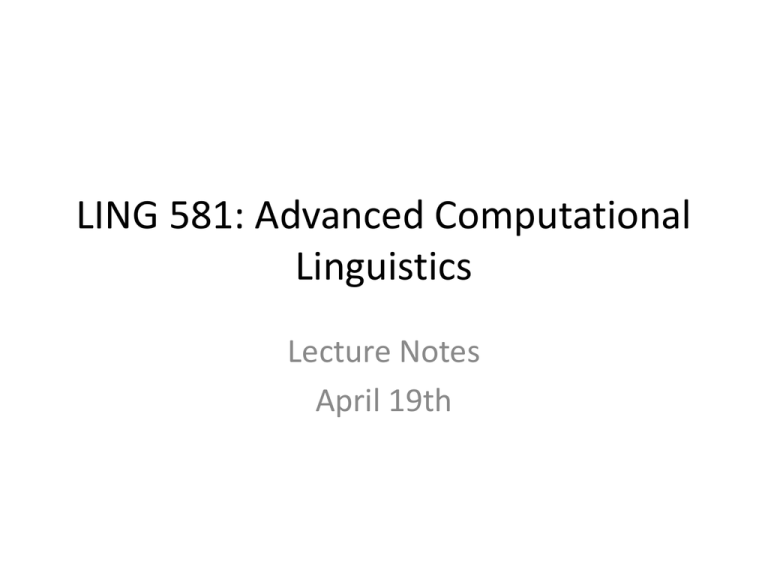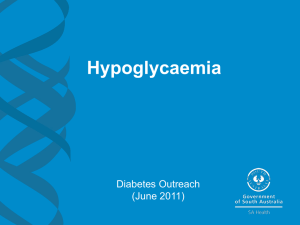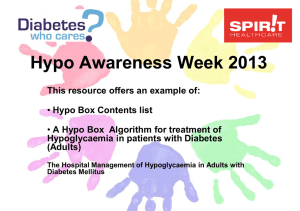lecture14
advertisement

LING 581: Advanced Computational
Linguistics
Lecture Notes
April 19th
Today Topic
WordNet
• Did everyone manage to install?
1. WordNet 3.0 package
2. wnb (WordNet browser)
• export PATH=/usr/local/WordNet-3.0/bin:$PATH
3. WordNet::QueryData Perl Module
Need them to do your homework (out today)
wnb
• WordNet browser:
wnb
• Setup:
– export PATH=/usr/local/WordNet3.0/bin:$PATH
– wnb
– Options: see sense numbers
(we’ll need these later)
wnb
• Hypernums (going up the hierarchy):
wnb
• Hyponums (going down the hierarchy):
wnb
• Holonyms (part-of hierarchy):
wnb
• Meronyms (has parts, plus inherited):
wnb
• Meronyms (has parts, plus inherited):
wnb
• Derivationally related (different part-of-speech):
wnb
• Domain:
wnb
• Verbs
wnb
• Coordinate terms (up 1, down 1)
wnb
• Troponyms (ways to):
wnb
• Derivationally related to (parts of speech):
wnb
• Adjective
wnb
• Antonyms:
wnb
• Value of:
• Related to:
wnb
• Pertains to:
axial
abaxial (relevant to FNA project)
in old WordNet version (1.7.1)
abaxial see also axial
no connection here… as we’ll see
Programmed Search
• using Perl Module Query Data
perldoc WordNet::QueryData
• Start up
– use WordNet::QueryData;
– my $wn = WordNet::QueryData->new( noload =>
1);
– noload => 0 (caches indexes in computer memory,
slower startup, faster lookup time)
perldoc WordNet::QueryData
• querySense, queryWord
– 1st argument
•
•
•
•
•
•
(1) word returns list of word#pos
Example: $wn-‐>querySense("run")
Answer: run#n, run#v
(2) word#pos returns list of word#pos#sense
Example: $wn-‐>querySense("run#v")
Answer: run#v#1, run#v#2, run#v#3, run#v#4, run#v#5, run#v#6,
run#v#7, run#v#8, run#v#9, run#v#10, run#v#11, run#v#12,
run#v#13, run#v#14, run#v#15, run#v#16, run#v#17, run#v#18,
run#v#19, run#v#20, run#v#21, run#v#22, run#v#23, run#v#24,
run#v#25, run#v#26, run#v#27, run#v#28, run#v#29, run#v#30,
run#v#31, run#v#32, run#v#33, run#v#34, run#v#35, run#v#36,
run#v#37, run#v#38, run#v#39, run#v#40, run#v#41
• (3) word#pos#sense + 2nd argument: a relation
perldoc WordNet::QueryData
• querySense, queryWord
– 1st argument
• (3) word#pos#sense + 2nd argument: a relation returns list of
word#pos#sense
• Example: $wn-->querySense("cat#n#1", "hypo")
• Answer: domestic_cat#n#1, wildcat#n#3
perldoc WordNet::QueryData
• To find other members of the synsets:
perl cat.perl
domestic_cat#n#1 house_cat#n#1 Felis_domesticus#n#1 Felis_catus#n#1
wildcat#n#3
perldoc WordNet::QueryData
• Possible relations for queryWord:
– “also” - also see
– “ants” – antonyms
– “deri” - derived forms (nouns and verbs only)
– “part” - participle of verb (adjectives only)
– “pert” - pertainym (pertains to noun) (adjectives
only)
– “vgrp” - verb group (verbs only)
perldoc WordNet::QueryData
• Possible relations for querySense:
–
–
–
–
–
–
–
–
–
–
–
–
–
–
–
also - also see
glos - word definition
syns - synset words
hype – hypernyms
inst - instance of
hypes - hypernyms and "instance of”
hypo – hyponyms
hasi - has instance
hypos - hyponums and "has
instance”
mmem - member meronyms
msub - substance meronyms
mprt - part meronyms
mero - all meronyms
hmem - member holonyms
hsub - substance holonyms
–
–
–
–
–
–
–
–
–
–
–
–
hprt - part holonyms
holo - all holonyms
attr - attributes (?)
sim - similar to (adjectives only)
enta - entailment (verbs only)
caus - cause (verbs only)
domn - domain – all
dmnc - domain – category
dmnu - domain – usage
dmnr - domain – region
domt - member of domain - all (nouns only)
dmtc - member of domain - category (nouns
only)
– dmtu - member of domain - usage (nouns
only)
– dmtr - member of domain - region (nouns
only)
perldoc WordNet::QueryData
• validForms: 1 argument word or word#pos
perl validforms.perl
go#v
Note: in documentation “lay down#v” returns lay_down#v, lie_down#v
“bank” returns bank#n bank#v
perldoc WordNet::QueryData
• level: one argument word#pos#sense
wnb (WordNet browser)
• Exercise:
– find the
relationship
between
minibike and
convertible
Programmed search
• We can write a program to find the minimum distance
between word senses: bfs.perl (on website)
Programmed search
mark is used to count the
depth of breadth-first search
hash %seen holds already visited nodes so we don’t loop
semantic distance = depth of breadth-first search when $end is matched
Programmed search
Example
Synset: minibike#n#1 motorbike#n#1
Programmed search
get node to expand
bookkeeping for
depth of search
record node as seen
Programmed search
node is related to newnode via rel
increment node count
if $end is found, jump out of nested
loop up to scope FOUND
if we haven’t seen
newnode before,
queue it for later
expansion
Programmed search
only two ways to get to the end of the program,
either we found our target node $end
or $n is no longer < $max
Programmed search
• Exercise revisited:
– find the relationship between minibike and convertible
– perl bfs.perl minibike#n#1 convertible#n#1
– Found at distance 4 (74 nodes explored)
– perl bfs.perl convertible#n#1 car#n#1
– Found at distance 1 (1 nodes explored)
Note:
– perl bfs.perl convertible#n#1 minibike#n#1
– Found at distance 4 (255 nodes explored)
Semantic relatedness
can we compare
concept distances?
Programmed search
• More informative search
– we can modify the program to make each node keep a
path, i.e. history, of the relations and nodes
– website: bfs2.perl (quick and dirty implementation)
– example:
– perl bfs2.perl minibike#n#1 convertible#n#1
– Found at distance 4 (74 nodes explored)
– convertible#n#1 hypo car#n#1 hypo
motor_vehicle#n#1 hype motorcycle#n#1 hype
minibike#n#1
Programmed search
• Code changes:
(uses Perl references to implement each node becoming a list itself)
– my @queue = ([$start], ['mark']);
square brackets
builds a reference to a list
containing $start, another
for ‘mark’
picks out first element of the list
Programmed search
• Code changes (main loop):
puts $newnode $rel onto front
of the list referenced by $node_ref
same thing here except it makes
a fresh copy of the list called @new
(not the most space-efficient
implementation… but simple)
Programmed search
• Code changes (print out at the end):
because we’ve been adding relations and new nodes
@{$node_ref} is a list that contains the entire
history of how we got there
Programmed search
• Other examples:
– perl bfs2.perl minibike#n#1 roof#n#1
– Found at distance 5 (509 nodes explored)
– roof#n#1 hype sunroof#n#1 mero car#n#1 hypo
motor_vehicle#n#1 hype motorcycle#n#1 hype
minibike#n#1
– perl bfs2.perl convertible#n#1 roof#n#1
– Found at distance 3 (222 nodes explored)
– roof#n#1 hype sunroof#n#1 mero car#n#1 hype
convertible#n#1
Programmed search
• Not everything seems related:
(even when search limit is upped to 80000)
– perl bfs.perl chair#n#1 table#n#1
– Not found (distance 8 and 80008 nodes explored)
– perl bfs.perl table#n#1 chair#n#1
– Not found (distance 9 and 80215 nodes explored)
perl bfs.perl table#n#1 chair#n#1
Found at distance 9 (140548 nodes explored)
perl bfs2.perl table#n#1 chair#n#1
Found at distance 9 (140548 nodes explored)
chair#n#1 hypo seat#n#3 holo upholstery#n#1 hypo covering#n#2 hypo
artifact#n#1 hype decoration#n#1 hype flower_arrangement#n#1 hypo
arrangement#n#2 hype array#n#1 hype table#n#1
does the long chain still have meaning?
Programmed search
• So far ..
– explored used querySense with relations
hypo/hype/mero/holo
• More complete search
– add more relations and queryWord
– Website: bfs3.perl
Programmed search
• Example: axial/abaxial revisited…
– surely should be related through noun axis…
But
perl bfs3.perl abaxial#a#1 axial#a#3 500000
Max set to: 500000
Not found (distance 3 and 500029 nodes explored)
perl bfs3.perl axial#a#1 abaxial#a#1 500000
Max set to: 500000
Not found (distance 9 and 500002 nodes explored)
Programmed search
• Example:
– John mended the torn dress
– what can be deduced about the state of the world
(situation) after the event of “mending”?
– find the semantic relationship between mend and tear
bfs3.perl mend#v#1 tear#v#1
Found at distance 6 (58492 nodes explored)
tear#v#1 hypo separate#v#2 hype break_up#v#10 also break#v#4 ants
repair#v#1 hypo better#v#2 hype mend#v#1
perl bfs3.perl tear#v#1 mend#v#1
Found at distance 6 (33606 nodes explored)
mend#v#1 deri mender#n#1 hypo skilled_worker#n#1 hype cutter#n#3 deri
cut#v#1 hypo separate#v#2 hype tear#v#1
Programmed search
• Find all minimal length solutions.
• Website: bfs4.perl
• Example:
perl bfs4.perl mend#v#1 tear#v#1
Found at distance 6 (58492 nodes explored)
tear#v#1 hypo separate#v#2 hype break_up#v#10 also break#v#4 ants
repair#v#1 hypo better#v#2 hype mend#v#1
Found at distance 6 (58552 nodes explored)
rupture#v#1 deri rupture#n#3 hypo breakage#n#3 deri break#v#4 ants
repair#v#1 hypo better#v#2 hype mend#v#1
Found at distance 6 (67147 nodes explored)
tear#v#1 hypo separate#v#2 hype break_up#v#10 also break#v#4 ants
repair#v#1 hype tinker#v#3 hypo mend#v#1
Found at distance 6 (67207 nodes explored)
rupture#v#1 deri rupture#n#3 hypo breakage#n#3 deri break#v#4 ants
repair#v#1 hype tinker#v#3 hypo mend#v#1
Programmed search
Found at distance 6 (67429 nodes explored)
tear#v#1 hypo separate#v#2 hype break_up#v#10 also break#v#4 ants repair#v#1 hype
fill#v#9 hypo mend#v#1
Found at distance 6 (67489 nodes explored)
rupture#v#1 deri rupture#n#3 hypo breakage#n#3 deri break#v#4 ants repair#v#1 hype
fill#v#9 hypo mend#v#1
Found at distance 6 (71190 nodes explored)
tear#v#1 hypo separate#v#2 hype break_up#v#10 also break#v#4 ants repair#v#1 hype
piece#v#5 hypo mend#v#1
Found at distance 6 (71250 nodes explored)
rupture#v#1 deri rupture#n#3 hypo breakage#n#3 deri break#v#4 ants repair#v#1 hype
piece#v#5 hypo mend#v#1
Found at distance 6 (74452 nodes explored)
tear#v#1 hypo separate#v#2 hype break_up#v#10 also break#v#4 ants repair#v#1 hype
cobble#v#2 hypo mend#v#1
Programmed search
Found at distance 6 (74512 nodes explored)
rupture#v#1 deri rupture#n#3 hypo breakage#n#3 deri break#v#4 ants repair#v#1 hype
cobble#v#2 hypo mend#v#1
Found at distance 6 (75039 nodes explored)
tear#v#1 hypo separate#v#2 hype break_up#v#10 also break#v#4 ants repair#v#1 hype
point#v#14 hypo mend#v#1
Found at distance 6 (75099 nodes explored)
rupture#v#1 deri rupture#n#3 hypo breakage#n#3 deri break#v#4 ants repair#v#1 hype
point#v#14 hypo mend#v#1
Found at distance 6 (75321 nodes explored)
tear#v#1 hypo separate#v#2 hype break_up#v#10 also break#v#4 ants repair#v#1 hype
trouble-shoot#v#1 hypo mend#v#1
Found at distance 6 (75381 nodes explored)
rupture#v#1 deri rupture#n#3 hypo breakage#n#3 deri break#v#4 ants repair#v#1 hype
trouble-shoot#v#1 hypo mend#v#1
Programmed search
Found at distance 6 (75603 nodes explored)
tear#v#1 hypo separate#v#2 hype break_up#v#10 also break#v#4 ants repair#v#1
hype patch#v#3 hypo mend#v#1
Found at distance 6 (75663 nodes explored)
rupture#v#1 deri rupture#n#3 hypo breakage#n#3 deri break#v#4 ants repair#v#1
hype patch#v#3 hypo mend#v#1
Found at distance 6 (76859 nodes explored)
tear#v#1 hypo separate#v#2 hype break_up#v#10 also break#v#4 ants repair#v#1
hype sole#v#1 hypo mend#v#1
Found at distance 6 (76919 nodes explored)
rupture#v#1 deri rupture#n#3 hypo breakage#n#3 deri break#v#4 ants repair#v#1
hype sole#v#1 hypo mend#v#1
Found at distance 6 (78287 nodes explored)
tear#v#1 hypo separate#v#2 hype break_up#v#10 also break#v#4 ants repair#v#1
hype vamp#v#4 hypo mend#v#1
Found at distance 6 (78347 nodes explored)
rupture#v#1 deri rupture#n#3 hypo breakage#n#3 deri break#v#4 ants repair#v#1
hype vamp#v#4 hypo mend#v#1
Programmed search
Found at distance 6 (78722 nodes explored)
tear#v#1 hypo separate#v#2 hype break_up#v#10 also break#v#4 ants
repair#v#1 hype heel#v#5 hypo mend#v#1
Found at distance 6 (78782 nodes explored)
rupture#v#1 deri rupture#n#3 hypo breakage#n#3 deri break#v#4 ants
repair#v#1 hype heel#v#5 hypo mend#v#1
Found at distance 6 (79004 nodes explored)
tear#v#1 hypo separate#v#2 hype break_up#v#10 also break#v#4 ants
repair#v#1 hype darn#v#1 hypo mend#v#1
Found at distance 6 (79064 nodes explored)
rupture#v#1 deri rupture#n#3 hypo breakage#n#3 deri break#v#4 ants
repair#v#1 hype darn#v#1 hypo mend#v#1
Found at distance 6 (86457 nodes explored)
tear#v#1 hypo separate#v#2 hype cut#v#1 deri cutter#n#3 hypo
skilled_worker#n#1 hype mender#n#1 deri mend#v#1
All minimal solutions found
Homework
• Use the browser and programs, possibly modified, e.g.
more relations, to report on the semantic relationship
between the highlighted concepts:
1.
2.
3.
4.
5.
6.
7.
•
Mary cleaned the dirty table
The waiter filled every empty glass
Mary fixed the flat tire
Mary fixed the leaky tire
Bill swept the dirty floor clean
Mary rescued the drowning man
He managed to comfort the crying baby
Event-based Models of Change and Persistence in Language (Pustejovsky, 2000)






